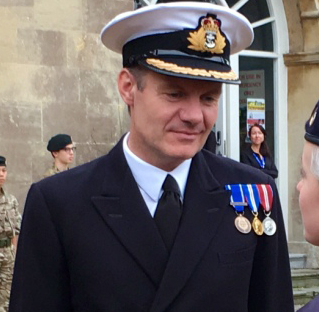Nigeria
| | This section needs expansion. You can help by adding to it. (April 2012) |
A principal warfare officer (PWO), is one of a number of warfare branch specialist officers.
In Australia, a PWO is a Royal Australian Navy officer who has completed PWO training. [1] The Australian PWO course is delivered at HMAS Watson. [2] Such officers are awarded the Principal Warfare Officer badge. [3]
| | This section needs expansion. You can help by adding to it. (April 2012) |
In the UK, a PWO is a naval officer who has completed PWO course either by attending the UK course at the Maritime Warfare School at HMS COLLINGWOOD or by attending a suitable international equivalent.
Introduced in 1972, the RN PWO Course has set the world standard for Warfare Officer training. The course usually marks a watershed in a Warfare officer’s career and successful completion is a prerequisite for FF/DD Command. PWO students are usually Warfare branch senior Lieutenants or junior Lieutenant Commanders drawn from all specialisations; Surface Warfare Officers comprise the bulk of students but Fleet Air Arm, Mine Warfare Officer, Mine Clearance Diving Officer, Hydrographic & Meteorologist, Royal Fleet Auxiliary, Submariner and foreign officers are allocated places provided that they reach certain criteria
Originally based at the School of Maritime Operations then based at HMS DRYAD, the RN's PWO course was formally a joint course with the Royal Australian Navy until the RAN established their own organic course. The course moved to the Maritime Warfare School at HMS COLLINGWOOD in 2004. The current iteration of PWO Course (known as PWO17) was a significant redesign of the course and put more influence on being a Defence Watch PWO in a conflict scenario. Originally PWOs had been trained to specialise in one sphere of warfare (AAW, ASuW, ASW) and received little training on the other spheres. More recently the Defence Watch PWO concept developed where all PWOs are trained in all spheres of warfare and will then sub-specialise later in their careers as their interests and aptitude develop. Prior to PWO17, there was an impression in some quarters that RN PWOs were being trained for peace time operations, with an over emphasis on exercise safety. The PWO17 concept was designed to address this.
PWO course is currently (working) 45 weeks long and split into three phases, Maritime General Phase (shared with specialised Submariner and Aviator courses), Maritime Tactical Phase (split into different environments - ASW, ASuW, Gunnery, AAW) and Maritime Execute Phase.
5 weeks. The initial common phase is attended by all Surface, Submariner, and Aviator PWO courses, as well as those completing the Maritime Planning Officer Course, and provides a baseline level of advanced warfare knowledge through lectures, table top tactics, and the unique amalgamation of understanding brought by the different branches. On completion of this phase all but the core PWO students depart for further joint and specialist training.
24 weeks. The purpose of the Tactical Phase is to build upon the Warfare knowledge established in the General Phase and apply it to tactical situations in the Air, Surface and Sub-Surface Warfare spheres. The Maritime Composite Training System simulators are used throughout the phase to provide realistic practical application of these skills.
19 weeks. The final phase where all the skills developed in the previous phases are brought together in multi-threat simulations. The phase starts with a set of initial simulator assessments, develops with assessments at sea in an FF/DD and culminates in final assessments in the MCTS simulators. The assessment weeks are interspersed with development of wider skillsets, including simulator training, lectures, visits, discussions and table top tactics. Students ability to plan at an operational and tactical level for a task group operation is also assessed during this phase.
PWOs are assigned to Frigates, Destroyers, Aircraft Carriers, amphibious assault ships as well as various battle staffs and headquarters. They derive their authority from the delegation of the Commanding Officer's personal responsibility for the operational conduct of the ship and for units under their command. [4]
PWOs assigned to Royal Navy ships have a myriad of duties, summarised below;

In 2020, the Royal Navy determined PWO's deserved some formal recognition of the amount of training they received and the special position they inhabit within a fighting unit, the PWO pin and badge was subsequently commissioned and authorised for wear.
The pin was designed in consultation with the Naval Historical Branch (Ships’ Names and Badges Committee) and consists of a pair of heraldic sea horses (Hippocampi), representing the Surface Fleet, supporting a shield (which is emblematic of Defence), bearing a trident for sea power and crossed with naval swords for warfare, all assigned by the Naval Crown.

The Clearance Diving Branch is the specialist diving unit of the Royal Australian Navy (RAN) whose versatile role covers all spheres of military diving, and includes explosive ordnance disposal and maritime counter-terrorism. The Branch has evolved from traditional maritime diving, and explosive ordnance disposal, to include a special operations focus.

The Royal Naval Reserve (RNR) is one of the two volunteer reserve forces of the Royal Navy in the United Kingdom. Together with the Royal Marines Reserve, they form the Maritime Reserve. The present RNR was formed by merging the original Royal Naval Reserve, created in 1859, and the Royal Naval Volunteer Reserve (RNVR), created in 1903. The Royal Naval Reserve has seen action in World War I, World War II, the Iraq War, and War in Afghanistan.
The Submarine Warfare Insignia are worn by qualified submariners.

The surface warfare insignia is a military badge of the United States Navy which is issued to U.S. Navy personnel who are trained and qualified to perform duties aboard United States surface warships. There are presently four classes of the surface warfare pin, being that of line, staff, special operations, and enlisted. The line and enlisted surface warfare badges may be earned by United States Coast Guard personnel assigned to Navy commands. The various badge types are as follows:

The Republic of Singapore Navy (RSN) is the maritime service branch of the Singapore Armed Forces (SAF) responsible for defending the country against any seaborne threats and as a guarantor of its sea lines of communications. The RSN traces its origins to the Royal Navy when Singapore was still a crown colony of the British Empire. The service was formally established in 1967, two years after its independence from Malaysia in 1965, and had undergone a substantial modernisation ever since – which has led them into becoming the most powerful navy in Southeast Asia.
A naval flight officer (NFO) is a commissioned officer in the United States Navy or United States Marine Corps who specializes in airborne weapons and sensor systems. NFOs are not pilots (naval aviators), but they may perform many "co-pilot" or "mission specialist" functions, depending on the type of aircraft. Until 1966, their duties were performed by both commissioned officer and senior enlisted naval aviation observers (NAO).

Insignias and badges of the United States Navy are military badges issued by the United States Department of the Navy to naval service members who achieve certain qualifications and accomplishments while serving on both active and reserve duty in the United States Navy. Most naval aviation insignia are also permitted for wear on uniforms of the United States Marine Corps.

The Royal Navy Submarine Service is one of the five fighting arms of the Royal Navy. It is sometimes known as the Silent Service, as submarines are generally required to operate undetected.

This is a list of Royal Navy ratings rank insignia.

Operations Specialist is a United States Navy and United States Coast Guard occupational rating. It is a sea duty-intensive rating in the Navy while most of Coast Guard OS's are at ashore Command Centers.
Rear Admiral James Vincent Purcell Goldrick, was an Australian naval historian, analyst of contemporary naval and maritime affairs, and a senior officer of the Royal Australian Navy (RAN). Following his retirement from the RAN, Goldrick was a fellow at the Sea Power Centre – Australia and an adjunct professor in the School of Humanities and Social Sciences in the University of New South Wales at the Australian Defence Force Academy. He was also a member of the Naval Studies Group at the Australian Centre for the Study of Armed Conflict and Society, an adjunct professor in the Strategic and Defence Studies Centre of the Australian National University and a professorial fellow of the Australian National Centre for Ocean Resources and Security at the University of Wollongong. He was a visiting fellow at All Souls College, University of Oxford in the first half of 2015, and a non-resident Fellow of the Lowy Institute from 2013 to 2018.

The US employs divers in several branches of the armed forces, including the navy, army, marines, air force and coast guard.
Fleet Command is responsible for the command, operations, readiness, training and force generation of all ships, submarines, aircraft squadrons, diving teams, and shore establishments of the Royal Australian Navy. Fleet Command is headquartered at HMAS Kuttabul in Sydney, and is led by the Commander Australian Fleet (COMAUSFLT), also referred to as Fleet Commander Australia (FCAUST), which is a rear admiral (two-star) appointment.

The Navy Command is the current headquarters body of the Royal Navy, and as of 2012 its major organisational grouping. It is a hybrid, neither a command, nor simply an installation. Royal Navy official writings describe Navy Command Headquarters both as a physical site, on Whale Island, Hampshire, a collective formed of the most senior RN officers, and as a budgetary grouping.
The officer corps of the Royal Navy is the cadre of personnel holding a commission from the sovereign appointing them in a position of authority in the Royal Navy.
The Submarine Command Course (SMCC), previously known as the Commanding Officers Qualifying Course (COQC), and informally known as The Perisher is a training course for naval officers preparing to take command of a submarine.

Rear Admiral Stephen Richard Gilmore, is a retired senior officer of the Royal Australian Navy. He served as Commander Australian Fleet from October 2009 until December 2011, and as the Head Australian Defence Staff (Washington) and Australian Defence Attaché at the Embassy of Australia, Washington, D.C. from January 2014 until his retirement in 2017.
INS Satavahana is the premier Submarine Training Base of the Indian Navy and is located at Visakhapatnam, Andhra Pradesh. Training is carried out by the Submarine School (SMS) and the Escape Training School (ETS) and the School of Advanced Undersea Warfare (SAUW).

Commodore Nicholas Henry Charles Tindal is a senior Royal Navy officer who served as the commanding officer of RNAS Yeovilton until July 2020.

Vice Admiral Mark David Hammond, is a senior officer in the Royal Australian Navy (RAN), serving as the Chief of Navy since July 2022. He joined the RAN as an electronics technician in 1986 and, after being accepted for officer training, graduated from the Australian Defence Force Academy in 1990. Much of Hammond's career has been spent in the Submarine Service. He has served on operations in the Indo-Pacific, commanded the Collins-class submarineHMAS Farncomb, was Deputy Chief of Navy from 2018 to 2020, and served as Commander Australian Fleet from November 2020 to June 2022. He succeeded Vice Admiral Michael Noonan as Chief of Navy on 6 July 2022.